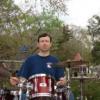
Posted
how to continue now? I can use the chords in other songs easily but how to sort out all this mess:
View post on imgur.com
even if I import it into a libary its not really getting much better.
is there some kind of workflow to gain control over the arrangement like auto select same colored elements and move them to new instruments?
Seitennummerierung
Fr., 04.03.2016 - 18:49 Permalink
auto select same colored elements and move them to new instruments
If you right click the track and select 'Split', it does exactly that. This would be a good place to start I think.
Fr., 04.03.2016 - 20:50 Permalink
the imported figure looks like three instruments merged into one. what does the phrase play?
to answer your question: hold down the mouse on the toolbar's symbol color and options will pop up to select all symbols of same type.
Sa., 05.03.2016 - 17:54 Permalink
cool thx. I wish I could sort the drums out too but it seems not to be possible in melodyne nor in synfire if they are mixed in one track with melodic content
Di., 08.03.2016 - 22:25 Permalink
I wish I could sort the drums out too but it seems not to be possible in melodyne nor in synfire if they are mixed in one track with melodic content
For decomposing an audio mix into separate instruments, Sony's SpectraLayers software is a better choice than melodyne.
Mi., 09.03.2016 - 06:21 Permalink
WOW didn't know about Sony's SpectraLayers - this looks awesome thx
Mi., 09.03.2016 - 10:31 Permalink
But you have to know that SpectraLayers does not work automatically. It requires definitely a lot of manual work. But it is useful work. It makes not much sense to import a MIDI track in Synfire, which contains mixed data from pitched and unpitched (drums) instruments. How should Synfire perform a harmonic analysis with this material?
So I would suggest the following workflow:
1. Import the audio file into SpectraLayers. Separate the instruments as much as possible into different layers.
2. Export separate audio files from SpectraLayers for each instrument.
3. Import the audio files into Melodyne. It's best, you have Melodyne studio, so you can edit the individual tracks in one go.
4. Export MIDI from Melodyne for each track.
5. Import the MIDI tracks into a DAW. There you should clean up the data before you import it into Synfire. Erase unneccessary notes, correct wrong notes, adjust length of the notes, and so on. Quantization is also a good idea. Listen how it sounds. Does it fairly come close to the original track? In general one can say that this type of editing is easier in a DAW than later in Synfire. Besides, you will facilitate the work for Synfire in the analysis of the data.
6. Import the MIDI tracks into Synfire. Make sure that you set the import algorithm for unpitched instruments such as drums to "static".
Mi., 09.03.2016 - 14:53 Permalink
thanks. this will bring very interesting results
Mi., 09.03.2016 - 15:36 Permalink
the only thing left is how to extract micotonal tuning from the original files. Its possible to create microtonal tuning files with Scala to import into VSTs but not to export tuning files from audio
Mi., 09.03.2016 - 20:34 Permalink
Its possible to create microtonal tuning files with Scala to import into VSTs but not to export tuning files from audio
No, I also don't know a tool which can do that. But with some fiddling around in Melodyne you could find out the tuning of an audio. You could move the pitch marks for the individual scale steps so that they match with the real pitches of the notes in the audio file (or use the Scale Detective to do that), then read the pitch values and compare them with pitch tables for the different tunings. But that method is probably not what you imagine.
Mi., 09.03.2016 - 20:52 Permalink
interesting idea - my approach would be to write down the frequencies shown in melodyne and type them into the scala files which are just very simple text files: (http://www.huygens-fokker.org/scala/examples.html)
Mi., 09.03.2016 - 23:28 Permalink
Wonder what the use of synfire is with harmony and microtonal music.
Your choice of chords (if any) would be very limited.
Do., 10.03.2016 - 08:39 Permalink
its getting better: http://i.imgur.com/0p0NUgy.png(link is external). what else can I do to get this under control?
That's a lot of symbols which makes the figures look more like audio ;-) As a general rule of thumb, figures should look simple and clean (they will still give you plenty music). Not that Synfire couldn't handle any kind of symbols, but it seems unlikely the original music your imported would involve such dense patterns.
As for microtonality, some microtonal scales will work, if they fit the following constraints:
1. Maximum 12 tones per octave.
2. Same interval pattern every octave.
In simple terms: Any scale that is playable on a standard MIDI keyboard and that can be created by tuning the instrument accordingly.
Scales with 19 tones, for example, or scales that do not repeat every octave, are not supported. Although these are rare and do not suit functional techniques anyway (circle of 5th, palettes, chords, harmonic functions), so you would probably need a separate software for that kind of music.
Do., 10.03.2016 - 08:43 Permalink
Try to import smaller chunks at a time. Cleanup and decompose them into building blocks, as suggested here:
(http://users.cognitone.com/tutorial/import)
(BTW: You can attach images to you posts. No need to use external hosters)
Do., 10.03.2016 - 11:32 Permalink
Wonder what the use of synfire is with harmony and microtonal music.
Your choice of chords (if any) would be very limited.
the synths are tuned via scala files not synfire. many VSTs can read scala files: (http://www.huygens-fokker.org/scala/)
Do., 10.03.2016 - 11:36 Permalink
For decomposing an audio mix into separate instruments, Sony's SpectraLayers software is a better choice than melodyne.
I played around with SSL yesterday and its pretty complex to mark all notes with the harmonic selection tool by hand. I will try a less complex song next time to get a better feel for it
Do., 10.03.2016 - 11:39 Permalink
Try to import smaller chunks at a time. Cleanup and decompose them into building blocks, as suggested here:
good point I will follow your and juergens tutorial but with a small loop at first
Do., 10.03.2016 - 11:44 Permalink
That's a lot of symbols which makes the figures look more like audio ;-) As a general rule of thumb, figures should look simple and clean (they will still give you plenty music). Not that Synfire couldn't handle any kind of symbols, but it seems unlikely the original music your imported would involve such dense patterns.
yeah good point I need to clean the midi file first before importing it - still the file in the screenshot song sounds really great when imported into logic afterwards but the melody is a bit muddy and there not much control so cleaning and splitting the files should change that. I will also try to split the 3 tracks from synfire into more tracks in logic to make it not sound so crowded anymore
Do., 10.03.2016 - 12:03 Permalink
A network exception occurred with embedding an URL
As for microtonality, some microtonal scales will work, if they fit the following constraints:
1. Maximum 12 tones per octave.
2. Same interval pattern every octave.In simple terms: Any scale that is playable on a standard MIDI keyboard and that can be created by tuning the instrument accordingly.
Scales with 19 tones, for example, or scales that do not repeat every octave, are not supported. Although these are rare and do not suit functional techniques anyway (circle of 5th, palettes, chords, harmonic functions), so you would probably need a separate software for that kind of music.
how does this acutally work if I just have some frequcencies like this: http://www.ovuca.com/research.html
I only understand the workflow you are describing on a theoretic level. How is this actually done in synfire?
In Scala I would just write these frequcencies into the Scala file manually in a text editor and load it into my supported VSTs like this:
! Easley Blackwood: harmonization of a mode in 15-tET, ! example 29 of "Modes and chord progressions in equal tunings", p. 195 ! Perspectives of New Music vol. 29/2, 1991. ! 0 exclude 10 0 tempo 800_000 0 program 5 0 velocity 64 0 frequency 261.6255653 0 equal 15 0 notation E15 ! 0 track 1 0 note C.1 480 0 note E\.1 480 480 note B\ 480 480 note D.1 480 960 note Bb/ 480 960 note D\.1 480 1440 note A\ 480 1440 note C.1 480 1920 note G 480 1920 note B\ 480 2400 note F#\ 480 2400 note A 480 2880 note F 480 2880 note A\ 480 3360 note E\ 480 3360 note G 480 3840 note Eb 480 3840 note G\ 480 4320 note D\ 480 4320 note F 480 4800 note C 960 4800 note E\ 960 ! 0 track 2 0 note C 480 0 note G 960 480 note G.-1 480 960 note Bb.-1 480 960 note F 960 1440 note F.-1 480 1920 note G.-1 480 1920 note D 960 2400 note D.-1 480 2880 note F.-1 480 2880 note C 960 3360 note C.-1 480 3840 note Eb.-1 480 3840 note Bb.-1 960 4320 note Bb.-2 480 4800 note C.-1 960 4800 note G.-1 960
http://www.huygens-fokker.org/scala/examples.html
(the quote above messed up my formatting - scroll down to the bottom on http://www.huygens-fokker.org/scala/examples.html for correct formatting)
Do., 10.03.2016 - 22:00 Permalink
I under stand that the vst holds the .scala files. But it will have to be a 12 tone scale for it to work in synfire.
I've done some experiments with 12 tone pythagorean tuning in the past wich worked pretty well.
But for like 31 TET microtonal scales won't really work.
Do., 10.03.2016 - 23:00 Permalink
ah ok so how is it done?
Fr., 11.03.2016 - 02:09 Permalink
Just load some pythagorean tuning in your synths (u-he in my case) and see what sounds good by playing a sketch on some pallets ;)
Fr., 11.03.2016 - 08:45 Permalink
I want to take very specific microtonal scales from existing material instead of randomly loading one of the 4000 scala files.
Fr., 11.03.2016 - 12:50 Permalink
Never done that...but what's the point of importing that in Synfire ?
Waste of time if you ask me....
Fr., 11.03.2016 - 14:52 Permalink
Waste of time if you ask me....
Isn't dealing with music composition waste of time anyway these times? Nevertheless we are doing it...
So., 13.03.2016 - 00:48 Permalink
Wouldn't Audionamix' ADX TRAX Audio Separation Software be a better option than Melodyne or SpectraLayers? Haven't used it, because it's currently Mac only (but Win version is underway).
Btw, I have Melodyne.
Sa., 12.03.2016 - 16:07 Permalink
Interesting, I didn't know about ADX TRAX. Certainly worth to give it a try. However, I'm a bit sceptical. Under "How it works" they say virtually nothing about how it works. Looks as if it is mainly for extracting vocals.
Sa., 12.03.2016 - 23:30 Permalink
For songs with drums. Zyzaptiq Unmix drums is really getting the job done. Using Melodyne 4 to convert to midi after rendering in DAW.
So., 13.03.2016 - 02:03 Permalink
I thought I'd seen solo instruments mentioned somewhere. I'll try to get an opinion from an ADX TRAX user.
So., 13.03.2016 - 03:40 Permalink
Here's a quote from their website that specifically mentions solo instruments (emphasis mine):
"ADX TRAX Pro 2.6 goes beyond the automatic separation by giving users the ability to directly edit their results by time and frequency, adjust gain, attenuate or remove sounds, extract, raise or lower the level of a vocal or solo instrument in a mono or stereo mix and correct audio anomalies using effective restoration tools."
but ....., using ADX TRAX properly takes apparently substantial effort!
Seitennummerierung





